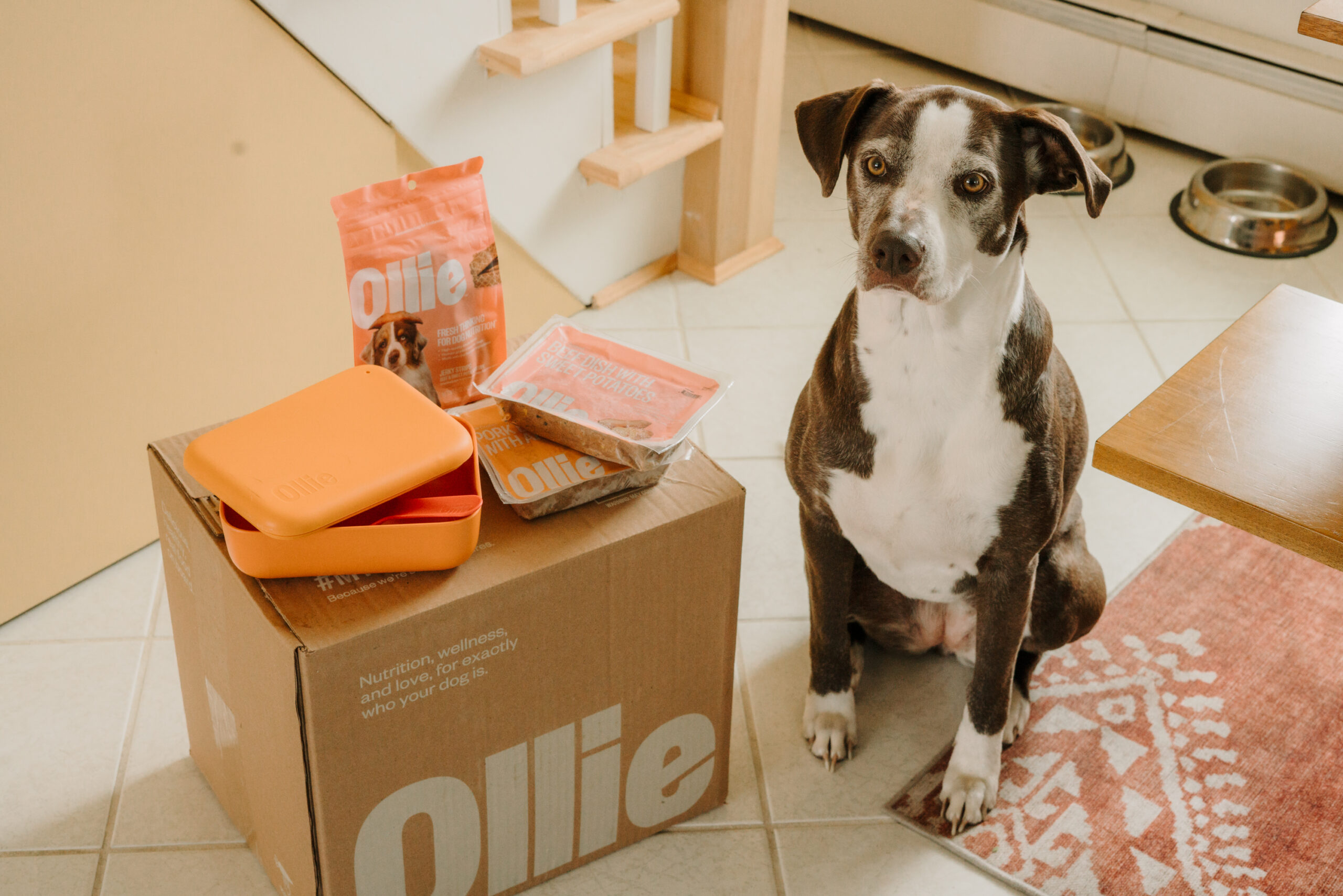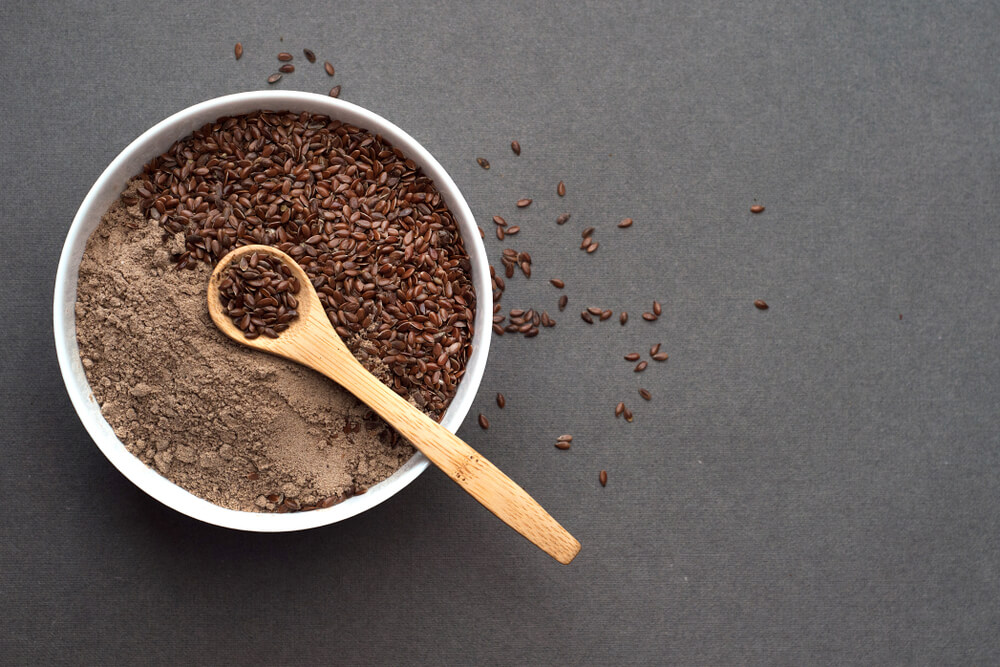Hey Ollie blog readers! We’re offering you an exclusive 60% OFF your starter box! Try now!
For dogs with allergies, sensitive stomachs, or other health concerns, a higher quality of life starts with food made from higher quality ingredients. The right nutrition can make a significant difference in managing their symptoms and increasing their comfort. Read on to learn how human-grade food can provide support for pup parents seeking better solutions for their dogs’ health challenges.
Understanding Human-Grade Dog Food
Human-grade dog food refers to products made with ingredients that meet the same quality and safety standards required for human consumption[1]. This distinction goes beyond marketing—it represents a fundamental difference in ingredient quality, processing standards, and nutritional value.
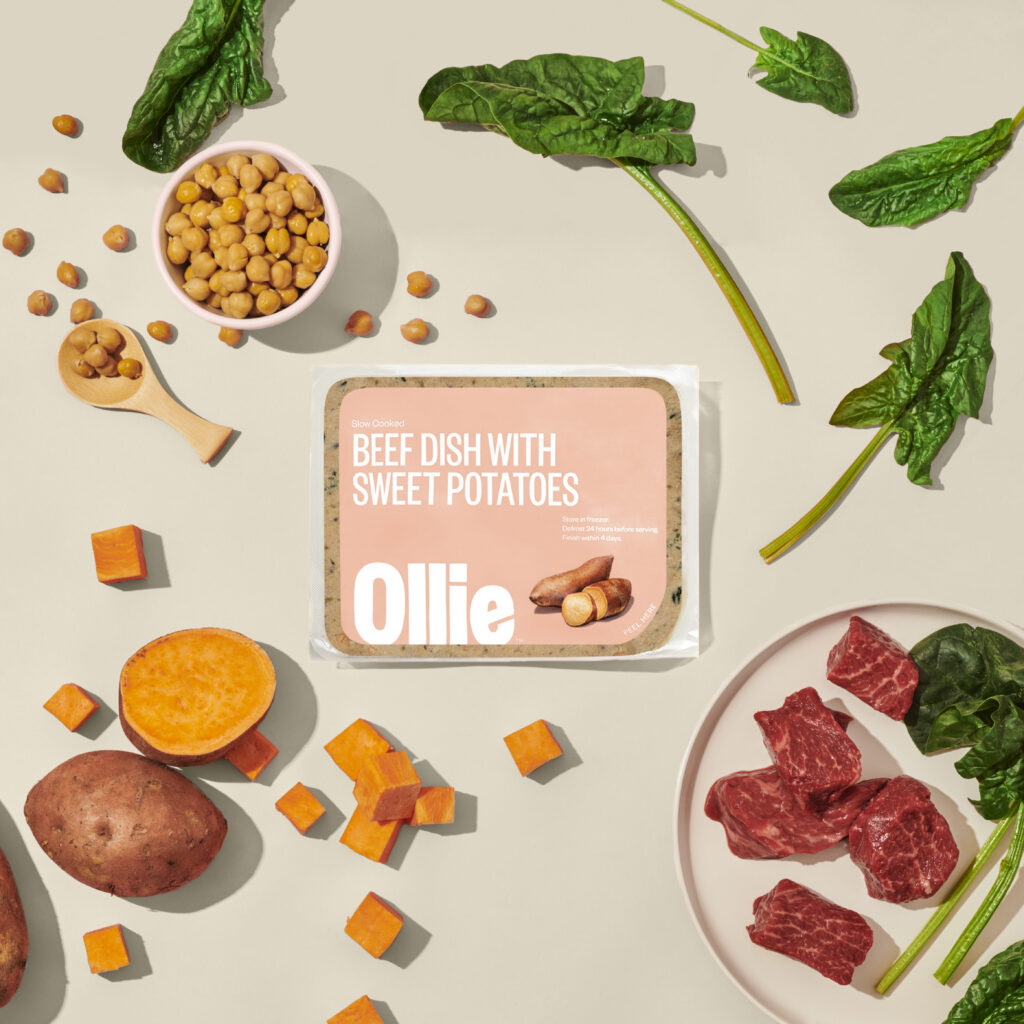
What Makes Food “Human-Grade”?
For dog food to qualify as human-grade, it must be manufactured, packed, and held according to federal regulations for human edible foods[2]. This means:
- Ingredients must be sourced from the human food chain
- Production must occur in facilities licensed to produce human food
- The entire process must follow human food safety protocols
- The finished product must be stored and transported according to human food standards
It’s important to understand that human-grade doesn’t simply mean “ingredients humans can eat.” Many pet foods contain ingredients that humans technically could consume but wouldn’t want to—like certain animal by-products or lower-quality grains that serve primarily as fillers[2].
How Human-Grade Ingredients Benefit Dogs with Health Issues
For dogs with existing health conditions, the switch to human-grade food can provide several meaningful benefits that address specific concerns.
Improved Digestive Health
Dogs with sensitive stomachs or digestive issues often respond positively to human-grade diets. The higher quality proteins and carefully selected ingredients are typically more digestible, which means:
- Less strain on the digestive system
- Better nutrient absorption
- Reduced gastrointestinal distress
- More consistent and healthier stool quality[3]
Human-grade foods often contain whole food ingredients that provide natural fiber and nutrients that support gut health. For dogs with chronic digestive issues, this can mean fewer episodes of upset stomach, less gas, and improved overall comfort.
Allergy Management
Food allergies and sensitivities in dogs can manifest as skin issues, ear infections, gastrointestinal problems, and more. Human-grade dog food can help address these concerns through:
- Cleaner ingredient profiles with fewer additives and preservatives that might trigger reactions
- Higher quality protein sources that are less likely to cause allergic responses
- Transparent ingredient lists that make it easier to identify and avoid specific allergens
Many pet parents report seeing improvements in their dogs’ allergy symptoms after switching to human-grade food, including reduced itching, decreased ear infections, and healthier skin and coat.
Enhanced Immune Function
The immune system plays a crucial role in managing chronic health conditions. Human-grade dog food often contains ingredients rich in natural antioxidants, vitamins, and minerals that support immune function[3].
Fresh, minimally processed ingredients retain more of their natural nutritional value, providing:
- Higher levels of bioavailable nutrients
- Natural antioxidants that fight inflammation
- Essential fatty acids that support cellular health
- Vitamins and minerals in their most usable forms
For dogs with autoimmune conditions or those recovering from illness, these nutritional advantages can help strengthen their body’s natural defenses.
Key Components of Quality Human-Grade Dog Food
Not all human-grade dog foods are created equal. When selecting a food for a dog with health issues, pay attention to these important factors:
Protein Quality and Source
Protein is the cornerstone of canine nutrition, especially for dogs with health concerns. High-quality human-grade dog foods feature:
- Named animal protein sources (like chicken, beef, or salmon) rather than generic “meat” or “animal” proteins
- Whole muscle meat rather than primarily by-products
- Appropriate protein levels for your dog’s specific health needs
For highly active breeds or those with higher energy requirements, adequate protein from quality animal sources helps maintain muscle mass and steady energy levels throughout the day[3].
Balanced Nutrition Profile
While addressing specific health concerns is important, a dog’s overall nutritional needs must still be met. Quality human-grade foods provide:
- Appropriate balance of proteins, fats, and carbohydrates
- Essential vitamins and minerals in bioavailable forms
- Omega fatty acids for skin, coat, and inflammatory support
- Limited artificial additives, preservatives, and fillers
This balanced approach ensures that while addressing one health issue, you’re not creating deficiencies or imbalances that could lead to other problems.
Freshness and Processing Methods
The way food is processed significantly impacts its nutritional value. Many human-grade dog foods emphasize:
- Minimal processing to preserve nutrient integrity
- Fresh or gently cooked ingredients rather than highly processed ones
- Small batch production for quality control
- Shorter shelf life but higher nutritional value
These methods help preserve the natural enzymes, antioxidants, and nutritional compounds that can be destroyed in conventional pet food manufacturing processes.
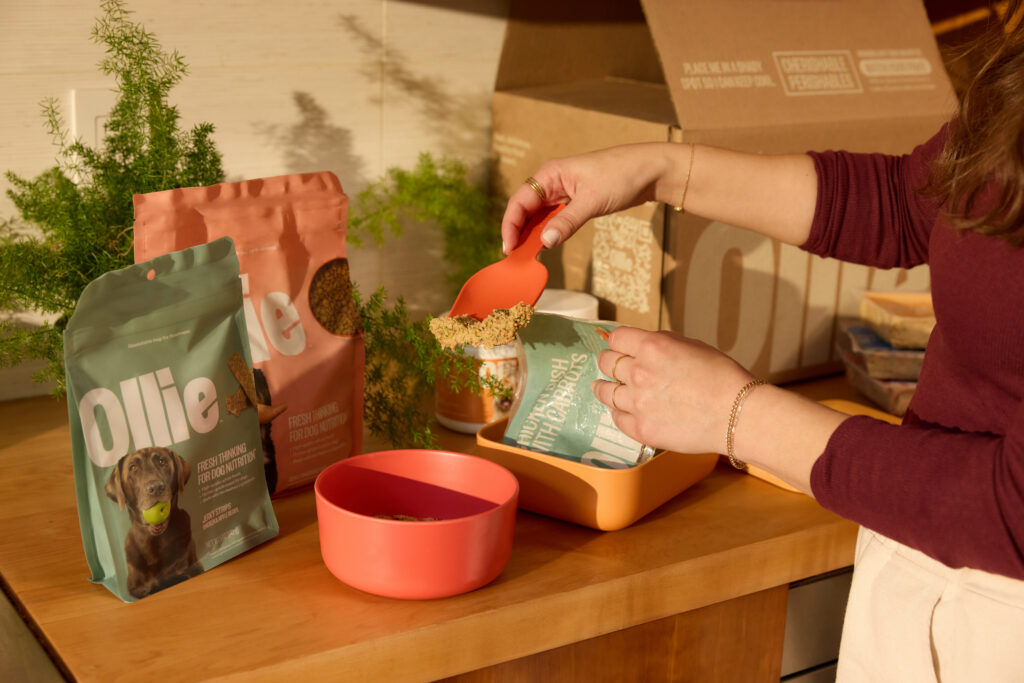
Transitioning Your Dog to Human-Grade Food
When introducing human-grade food to a dog with health issues, a careful transition is essential to prevent digestive upset and to monitor how the new diet affects their condition.
Gradual Introduction
A slow transition over 7-10 days gives your dog’s digestive system time to adjust:
- Days 1-3: 25% new food, 75% current food
- Days 4-6: 50% new food, 50% current food
- Days 7-9: 75% new food, 25% current food
- Day 10: 100% new food
For dogs with particularly sensitive digestive systems, an even more gradual transition over 2-3 weeks may be beneficial.
Monitoring Health Changes
Keep track of how your dog responds to the new diet:
- Document any changes in symptoms related to their health condition
- Note improvements or changes in energy levels, coat quality, and stool consistency
- Watch for any new symptoms that might indicate an adverse reaction
- Consider keeping a food journal during the transition period
This information can be valuable for both you and your veterinarian in assessing the effectiveness of the dietary change.
Personalized Nutrition for Individual Health Needs
Every dog is unique, and their nutritional needs vary based on their specific health conditions, age, activity level, and other factors. Personalized nutrition plans take these individual needs into account.
Customized Meal Plans
Some human-grade dog food companies offer customized meal plans based on your dog’s:
- Age, weight, and activity level
- Breed and size
- Existing health conditions
- Food sensitivities or allergies
- Weight management goals
These personalized approaches ensure that your dog receives the right balance of nutrients to support their specific health needs rather than a one-size-fits-all solution.
Veterinary Collaboration
Working with your veterinarian when making dietary changes is particularly important for dogs with health issues:
- Discuss specific nutritional needs related to your dog’s condition
- Consider whether therapeutic diets might be necessary for certain conditions
- Determine appropriate caloric intake based on health status
- Plan regular check-ups to monitor how dietary changes affect health markers
Your vet can provide valuable guidance on whether a human-grade diet is appropriate for your dog’s specific health concerns and how to optimize it for their needs.
Cost Considerations and Practical Implementation
Human-grade dog food typically costs more than conventional options, but there are ways to make it more accessible for your budget.
Value vs. Cost Analysis
When evaluating the cost of human-grade food, consider:
- Potential reduction in veterinary bills from improved health
- Higher nutrient density may mean smaller serving sizes
- Improved quality of life for your dog
- Long-term health benefits that may reduce healthcare costs
Many pet parents find that the initial higher cost is offset by improvements in their dog’s health and reduced need for medications or treatments for chronic conditions.
Practical Feeding Approaches
If full human-grade feeding doesn’t fit your budget, consider these alternatives:
- Use human-grade food as a topper on conventional high-quality kibble
- Feed human-grade for one meal per day
- Use human-grade foods specifically for dogs with the most significant health issues in multi-dog households
- Gradually increase the proportion of human-grade food as your budget allows
These approaches can help you provide some of the benefits of human-grade nutrition while managing costs.
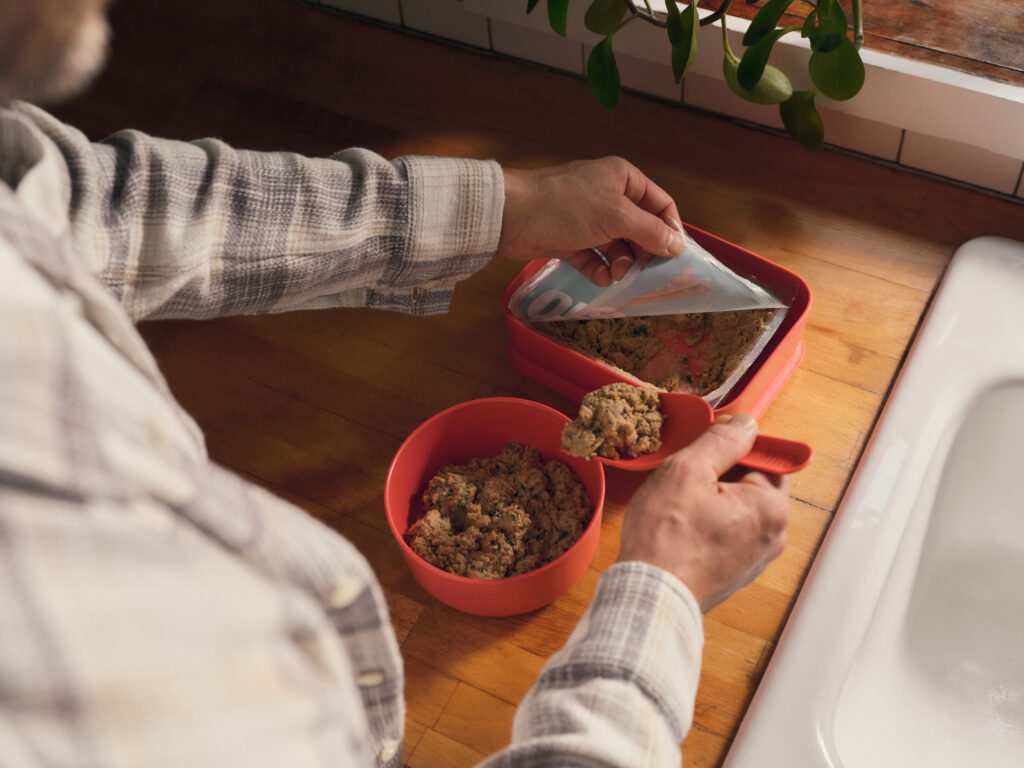
Ollie’s Approach to Human-Grade Nutrition for Dogs with Health Issues
Ollie has established itself as a leader in the human-grade dog food space, with a particular focus on addressing health concerns through nutrition. Their approach combines quality ingredients with personalized nutrition plans.
Ollie’s human-grade recipes are formulated by experts to ensure complete and balanced nutrition while addressing common health concerns. Their meals are:
- Made with whole food ingredients that meet human consumption standards
- Gently cooked to preserve nutritional integrity
- Portioned according to each dog’s specific caloric needs
- Delivered fresh on a regular schedule
For dogs with health issues, Ollie offers recipes with various protein options and ingredient profiles, making it easier to find options that work for dogs with specific sensitivities or allergies.
Frequently Asked Questions
How can I tell if my dog’s health issues are related to their diet?
Common signs that your dog’s health problems might be food-related include recurring skin issues, chronic ear infections, persistent digestive problems, and excessive itching or paw licking. If you notice these symptoms improve during food elimination trials or worsen after eating certain foods, diet is likely a contributing factor. Consult with your veterinarian for proper diagnosis and dietary recommendations.
Is human-grade dog food appropriate for all health conditions?
While human-grade food benefits many dogs with health issues, certain medical conditions may require specialized therapeutic diets formulated for specific health concerns. Dogs with kidney disease, for example, may need carefully controlled levels of certain nutrients. Always consult with your veterinarian before making dietary changes for dogs with diagnosed medical conditions.
How long before I see improvements after switching to human-grade food?
The timeline for improvement varies depending on the health issue and individual dog. Some pet parents notice digestive improvements within days, while skin and coat changes may take 4-6 weeks to become apparent. Chronic inflammatory conditions might show gradual improvement over several months. Keep a journal to track changes and be patient with the process.
Can I make human-grade dog food at home instead of purchasing it?
While home-prepared diets using human-grade ingredients are possible, they require careful formulation to ensure complete and balanced nutrition. Without proper supplementation and nutritional expertise, homemade diets risk creating deficiencies or imbalances. If you’re interested in home cooking, consult with a veterinary nutritionist to develop appropriate recipes for your dog’s specific health needs.
How do I store human-grade dog food properly?
Most fresh human-grade dog foods require refrigeration or freezing to maintain safety and nutritional quality. Follow the manufacturer’s storage instructions carefully, including recommended shelf life after opening. Unlike conventional kibble, fresh human-grade foods typically cannot be left out for extended periods, so adjust your feeding routine accordingly.
Making the switch to human-grade dog food like Ollie can be a transformative decision for dogs struggling with health issues. By providing cleaner, more digestible nutrition with higher quality ingredients, you’re giving your dog’s body the tools it needs to function at its best.
Citations
[1] https://www.petmd.com/dog/nutrition/what-is-human-grade-dog-food
[2] http://www.pawpots.ae/learn/switching-to-human-grade-dog-food
[3] https://www.thehonestkitchen.com/blogs/pet-wellness/human-grade-dog-food-benefits
Tagged As:

The nutrition your dog needs,
the food they want.

Enjoying our articles? Subscribe our Newsletters and get new articles directly to your inbox
You might also like
18 September 2025
6 MINS READ
Can Dogs Eat Flaxseed? Is Flaxseed Safe For Dogs?
Wondering if flaxseed is safe for your dog? This guide breaks down the benefits, risks, and best ways to add flaxseed, or flaxseed oil, to your pup’s diet.
18 September 2025
6 MINS READ
Why is My Dog Not Eating But Acting Normal? Causes & What To Do
Worried your dog isn’t eating but still acting normal? Here’s what could be going on and what to do to help your pup get their appetite back.
18 September 2025
5 MINS READ
Can Dogs Eat Crab? Is Crab Meat Safe For Dogs?
Thinking about giving your dog crab meat? Find out if it’s safe, what risks to watch for, and when crab might do more harm than good.
